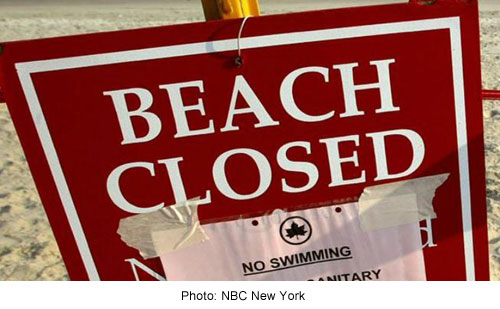 An annual water quality report released Wednesday underscores just how far we have to go before Long Island Sound’s waters are healthy for swimming every day.
An annual water quality report released Wednesday underscores just how far we have to go before Long Island Sound’s waters are healthy for swimming every day.
The 2013 “Testing the Waters” report, which compiles beach closing data from around the country during the summer of 2012, showed bacteria counts above the safe level 15 percent of the time for beaches in the Bronx, 14 percent for Westchester, 7 percent for Suffolk and 6 percent for Nassau. The water quality samples were taken during regular testing by local health departments.
The result was that those four counties, plus two Sound beaches in Queens, lost 1,023 beach days (the number of beaches multiplied by the number of days they were closed).
Connecticut’s Sound beaches had an additional 298 days of closings or advisories—lower than 2011’s sky-high figure of 538 beach days lost (due in large part because of Hurricane Irene), but still more than double the number of closings or advisories counted in 2010, 2009, or 2008.
We here at Save the Sound do not think “middle of the pack” is acceptable when it comes to safe water. Connecticut ranked 17th out of 30 listed states and New York ranked 22nd, said the Natural Resources Defense Council, which issues the annual report. Clearly, the residents of the Long Island Sound region deserve cleaner water.
Most of the closings were related to bacteria in sewage and other sources that reach the Sound and its tributaries through deteriorating sewers, combined sewer overflows and stormwater runoff. The problem is so severe that many communities routinely ban swimming any time it rains at least half an inch within 24 hours.
You can read the report’s county-by-county summary for New York here and for Connecticut here.
Save the Sound has been advocating for infrastructure improvements and upgrades around the Sound, and is working with a number of communities on water testing programs and green infrastructure projects in hopes of stopping the problem and identifying its sources. Strong funding for the Connecticut Clean Water Fund, proposed by Governor Malloy and passed by the legislature, is expected to support a number of pollution-reducing projects on the Connecticut side of the Sound.
Save the Sound released a statement yesterday, in which Leah Schmalz, director of legislative and legal affairs, said: “Just an inch of rain in 24 hours causes many local health departments around the Sound to shut down beaches. Drought conditions may provide the perfect beach weather—no rain means no contamination from stormwater runoff—but we can’t rely on Mother Nature to do our pollution control for us. If we want to enjoy our coastline, eat local seafood, and promote tourism along the shore, rain or shine, we have to be proactive. That means stopping pollution at the source by upgrading our sewage treatment plants and fixing leaky pipes, separating the combined sewer overflows that dump almost two billion gallons of untreated sewage into our waterways each year, and investing in innovative stormwater runoff solutions like drain filters and green infrastructure.”

3 thoughts on ““Testing the Waters” Shows Again How Dirty Long Island Sound’s Beaches Can Be”
Comments are closed.